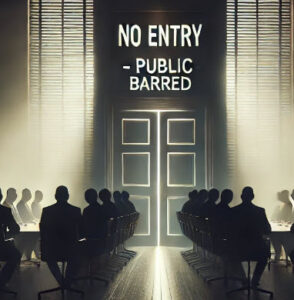Secret 15 to 20 minute meeting held February 18 on the safety issue with no information made public afterwards: Should students and the public be worried?
 The Yavapai Community College Governing Board’s first order of business at its February 18 meeting was to call a secret executive session to discuss “Facility Safety and Security Measures.” Only three of the five Governing Board members attended the secret meeting in addition to College president Dr. Lisa Rhine.
The Yavapai Community College Governing Board’s first order of business at its February 18 meeting was to call a secret executive session to discuss “Facility Safety and Security Measures.” Only three of the five Governing Board members attended the secret meeting in addition to College president Dr. Lisa Rhine.
The closed-door session, allegedly “ hosted” by Rhine, lasted approximately 15 minutes and the topic was “facility safety.” When the attendees emerged from the session, they were smiling. However, not a word was uttered about the supposed campus safety claim being made by Chair Deb McCasland.
Notably, before Tuesday’s Board meeting, McCasland claimed in an email sent to the Governing Board members that she had learned of “safety concerns related to our board meetings.” The concerns, whatever they were, appeared so serious to her that she switched the February 18 live meeting from the Rock House on the Prescott Campus to one on zoom.
Despite the change, McCasland has continued to withhold from the public any information about the alleged safety concerns.
Deepening the mystery, at least two District Governing Board members had sought an explanation or evidence from McCasland to substantiate her safety concern claim prior to Tuesday’s secret executive meeting. Yet, even when directly asked via email by them for facts, she rejected the request.
The entire mystery surrounding the public facility safety claim isn’t just unusual—it’s deeply unsettling to students at Yavapai Community College and the public.
 COMMENTARY: The actions by the Trump administration’s newly created Department of Government Efficiency (DOGE) may have a significant impact on the operations of Yavapai Community College. There is concern because DOGE is already taking away millions of dollars in existing grants and contracts from various educational institutions. In addition to this concern, the Trump administration has mandated that educational institutions eliminate anything that directly or indirectly might be linked to what are commonly called “Diversity, Equity and Inclusion (DEI)” programs or projects.
COMMENTARY: The actions by the Trump administration’s newly created Department of Government Efficiency (DOGE) may have a significant impact on the operations of Yavapai Community College. There is concern because DOGE is already taking away millions of dollars in existing grants and contracts from various educational institutions. In addition to this concern, the Trump administration has mandated that educational institutions eliminate anything that directly or indirectly might be linked to what are commonly called “Diversity, Equity and Inclusion (DEI)” programs or projects. The Patty McMullen-Mikles art Gallery on the Verde Campus will host a unique exhibit starting February 25 and running until March 27. An opening reception for the exhibit, Sustainable Art, will be held Thursday, March 6 from 5 – 7 p.m.
The Patty McMullen-Mikles art Gallery on the Verde Campus will host a unique exhibit starting February 25 and running until March 27. An opening reception for the exhibit, Sustainable Art, will be held Thursday, March 6 from 5 – 7 p.m. The Yavapai Community College District Governing Board will hold a meeting on Tuesday, February 18, via YouTube. The meeting was originally scheduled to take place at the Rock House on the Prescott Campus. However, Board Chair Deb McCasland abruptly changed the format to a virtual Zoom meeting, informing the Board in part that “after learning of safety concerns related to our board meetings,” she “decided that governing board meetings will be held virtually until further notice.”
The Yavapai Community College District Governing Board will hold a meeting on Tuesday, February 18, via YouTube. The meeting was originally scheduled to take place at the Rock House on the Prescott Campus. However, Board Chair Deb McCasland abruptly changed the format to a virtual Zoom meeting, informing the Board in part that “after learning of safety concerns related to our board meetings,” she “decided that governing board meetings will be held virtually until further notice.”



 At the January 28, 2025, Governing Board meeting, Yavapai Community College economist and data analytics expert Ryan Jones presented an analysis of a recent HOPE survey that showed the percentage of homeless students within the College’s student population. According to the survey—produced by Temple University and distributed to participating colleges, including Yavapai Community College—six percent of Yavapai’s student body reported experiencing homelessness at some point in the past year.
At the January 28, 2025, Governing Board meeting, Yavapai Community College economist and data analytics expert Ryan Jones presented an analysis of a recent HOPE survey that showed the percentage of homeless students within the College’s student population. According to the survey—produced by Temple University and distributed to participating colleges, including Yavapai Community College—six percent of Yavapai’s student body reported experiencing homelessness at some point in the past year. At the January 28, 2025, meeting of the Yavapai Community College District Governing Board, Community College economist and data analytics expert Ryan Jones presented an analysis of income levels and the rate of poverty in Yavapai County.
At the January 28, 2025, meeting of the Yavapai Community College District Governing Board, Community College economist and data analytics expert Ryan Jones presented an analysis of income levels and the rate of poverty in Yavapai County.